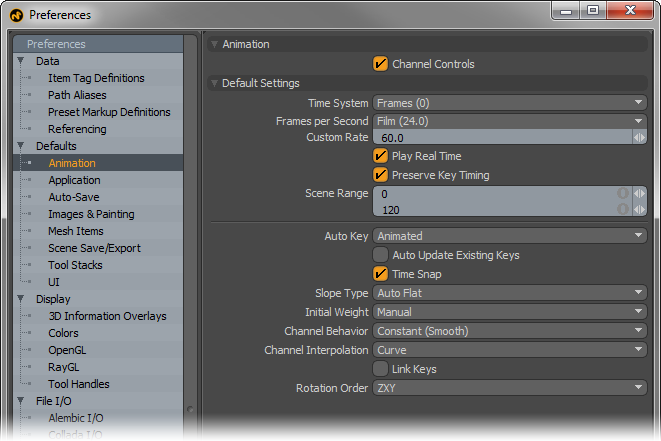
Animation--
Channel Controls: This option toggles MODO's ability to set keyframes on specific attributes within the viewport panels. When disabled it removes the keying fields, the default enabled state allows users the ability to set a keyframe directly next to the attribute (using the small circle control preceding each input field).
 Channel Controls disabled |  Channel Controls enabled |
Default Settings--
Time System: The Time System determines how MODO displays time in both the Timeline and input fields related to timing. This option determines the default 'Time Systems' for any new scenes as well. Users may modify these settings independently for each scene in the Scene item. (Users may also input alternate time styles into dialogue and MODO will convert to the chosen format, such as entering 3.25s will display 00:03:06 with SMPTE format time system)
Frames- Indicates frames as sequential numbers, using standard numbering format.
Seconds- Indicates frames as a passage of time, using the "0.0s" format.
SMPTE- SMPTE time code specifies frames utilizing a shorthand method "00:00:00:00"; representing hours:minutes:seconds:frames
Film Code- Specifies frames by the length of the film in feet (linear measurement) using "0.0 + 0" format.
Frames per Second: Frames Per Second, usually referred to as FPS, is the number of still images that playback in sequence in one second of real time. Users can specify a frame rate using the dropdown menu applying standard definitions, such as Film (24 fps), PAL (25 FPS), and NTSC (29.97 fps). This option determines the default FPS value for new scenes. Users may modify these settings independently for each scene in the Scene item. Choosing the 'Custom...' users can specify alternate custom values using the 'Custom Rate' option.
Custom Rate: If 'Custom' is selected as the default 'Frames Per Second', users can define the custom value in this field.
Play Real Time: When the 'Play Real Time' option is enabled, MODO will attempt to play back the sequence at the true speed, skipping frames if necessary. When disabled, MODO will play back every frame in sequence as fast as the system can handle it, which may be faster or slower than the specified 'Frames Per Second' value.
Preserve Key Timing: When enabled, MODO will retain the timing of keyframes when the 'Frames Per Second' (frame rate) values is modified, adjusting their position in the timeline as necessary. When disabled frames will retain their timeline position, which will change their position in time. For example: An animation is timed with a keyframe at frame 120 of the timeline. At 30fps, the key appears at the 4 second mark. If the 'Frames Per Second' is changed to 24fps after the keyframe was set, with 'Preserve Key Timings' enabled the keyframe will be moved to frame 96 retaining its position in time at the 4 second mark. If disabled, at 24fps the keyframe will remain at frame 120, which will now be at the 5 second mark, in essence slowing down the animation speed by 20%.
Scene Range: This value specifies the default time duration for new scenes. Users can change the duration per scene in the Scene Item.
Auto Key: When items are moved in a scene, the auto key function can automatically create keyframes eliminating the need to manually create them. The different settings specify how keyframes are created, 'All' will generate keyframe data for all channels associated with the modified item, 'Animated' will only keyframe those values that have been edited or modified and 'None' disabled the auto keyframe functionality. This option determines the default Auto Key behavior for new scenes. Users may modify these settings independently for each scene in the Scene item.
Auto Update Existing Keys: This option is only available when 'Auto Key' is 'Off'. Normally when Auto Key is off any edits that are made will be discarded when the current time is changed unless they have been manually keyed. This option allows existing keyframes to be updated automatically if their values are changed without requiring manual keying, un-keyed changes will still be discarded when the current time is changed.
Time Snap: The time snap toggle when enabled will 'snap' the current time indicator as well as any keyframes to whole frame values. Do define sub-frame keyframes disable this option.
Slope Type: This option determines the default 'Slope' type applied to new keyframes. See the Graph Editor for Slope definitions.
Initial Weight: This option determines the default 'Weight' type applied to new keyframes. See the Graph Editor for Weight definitions.
Channel Behavior: This option determines the default 'Channel Behavior' which specifies how a channel will act outside of the keyframed range. See the Graph Editor for information on Pre and Post Channel Behaviors.
Channel Interpolation: This option determines the default 'Channel Interpolation' method. See the Graph Editor for information on 'Curve' interpolation behavior.
Link Keys: When the 'Link Keys' button is active in the Graph Editor (its background will change to orange), associated keyframes will remain linked together in time, meaning that, for properties like Position, Rotation and Scale that each have associated X,Y and Z values, editing a single axis value, by moving it forward or backwards in time, will keep all the keyframe positions linked together as if all 3 were selected. When inactive, only the selected channels will be modified. This option determines the default 'Link Keys' behavior.
Rotation Order: Changing the order that rotations are applied can sometimes help to reduce or even eliminate gimbal lock (gimbal lock is when two axes rotate into a parallel angle and lose a degree of rotation). This option determines the default Rotation Order for all new items. Rotation order can also be adjusted on a per item basis in its associated Property panel when selected.
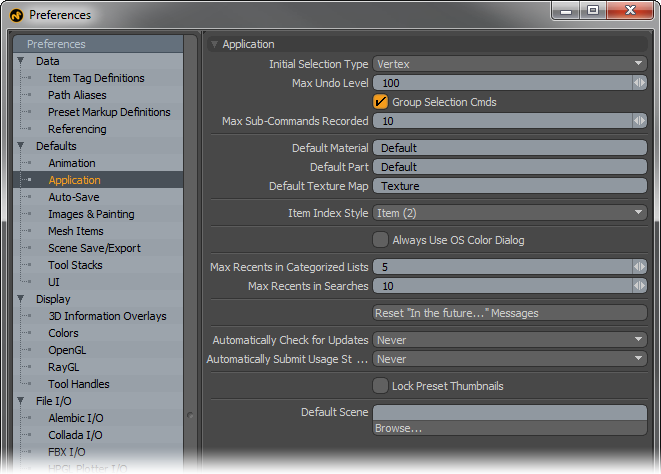
Application--
Initial Selection Type: This option simply determines the default selection mode when MODO is first opened.
Max Undo Levels: The undo history is viewable within the 'Command History' viewport. The 'Max Undo Levels' controls the maximum number of steps backwards users can go in the history. The default value of '100' is generally very good at allowing users leeway to step backwards through the history. Increasing the value will allow users to go further back in time, so to speak, but will also increase memory usage. For memory intensive scenes, it may be beneficial to reduce this value to reduce total memory overhead.
Group Selection Cmds: When this option is enabled, MODO will group multiple consecutive selection actions into a single undoable action. The grouping size is determined by the 'Max Sub-Commands Recorded' Value.
Max Sub-Commands Recorded: This option determines the maximum number of consecutive actions grouped into a single 'undoable' action when the 'Group Selection Cmds' option is enabled.
Default Material: This option determines the default material tag applied to newly created polygons. This will also be the default name that appears in the 'Polygon Set Material' dialog box when defining new material tags.
Default Part: This option determines the default name used for new part tags. Name appears in the 'Polygon Set Part' dialog box.
Default Texture Map: This option determines the default name used for new and auto-generated UV maps. Name appears in the 'VMap List' viewport.
Item Index Style: Scenes cannot have multiple items with identical names (much like program files in the same folder), when this occurs, MODO will automatically rename the item, be it a shader tree layer, item layer or vertex map, appending a numeral to the end of the defined names in a style determined by this option.
Use OS Color picker: When enabled, MODO will default to using the operating system specific color picker, duplicating the behavior of pre-501 versions. When disabled, MODO will use its own internal color picker.
Max Recents in Categorized Lists: Many 'Add' menus, such as 'Add Layer' in the Shader Tree or 'Add Item' in the Item list have a 'Recent' menu at the top of the list to hold the most recent items added during the present MODO session. Users can adjust this setting to determining the maximum number of recent entries in the menu.
Max Recents in Searches: Several of the list viewports (like the Items List and the Shader Tree) offer a search function through the use of the small 'F' button. Previous search terms can be cached in the dropdown menu when searching, allowing speedier subsequent searches for the same term. The 'Max Recents in Searches' determines the number of search terms that will be cached for this purpose.
Reset "In the Future...": Messages: Many pop-up dialog boxes in MODO provide a function to dismiss them in the future. For example, when welding pairs of points consecutively, users can dismiss future popups of the same dialog box using the 'In the Future' setting in the pop-up itself. Users can use this button to reset all these types of pop-ups to their factory installed state (meaning, if they have been dismissed permanently, this will bring them back).
Automatically Check for Updates: This option can be used to determine how often MODO checks the update server to see if a newer version is available. Users have the option to disable this action with the 'Never' option, or checking 'Every Launch', 'Daily' or 'Weekly'. When a newer build number is encountered, MODO will alert users to the new version. MODO will not update itself, it is up to the user to download the new version from their Foundry user account and install separately. Installation instructions are included in the Getting Started section of the documentation.
Automatically Submit Usage Statistics: Usage statistics of MODO sessions can be submitted to The Foundrythat helps us to determine application stability and in the case of instability, help us in determining the source of the problem. If users wish to help out in the efforts to improve MODO, they can opt to submit this information to us 'Every Launch', 'Daily' or 'Weekly'. Selecting the 'Never' option disables the function completely. The information collected and submitted is the MODO build version, the current OS, the last 10 commands run prior to any crash/hang, the duration of the last session and if it ended successfully or terminated in a crash/hang event. No personal information is collected. We hope you'll help us in our efforts to improve MODO, but we also understand should you choose to opt-out.
Lock Preset Thumbnails: When this option is enabled, saving over any existing presets will retain the existing thumbnail.
Default Scene: Everyone hates making the same changes over and over again with every new scene created. The 'Default Scene' option eliminates that need by allowing users to simply store their favorite settings, as well as any default lighting setups and geometry into a scene that is loaded by default when a 'New' scene is created or MODO is opened. Any file type that modo supports can be loaded as a default scene, and the specified scene can contain any number of elements, including any of the items types MODO supports, such as Lights, Cameras, Meshes and even Deformers and Falloffs.
The most common usage will be to store Camera, Frame and GI settings that will be used as the new default values, and maybe even a lighting setup and a ground plane if desired. To use, simply create a scene, with all the items and settings desired and save it somewhere on the local hard disk drive. Then close the file and use the 'Default Scene' Preference option to locate the saved file and then exit MODO. The next time MODO is opened, the saved scene will be present, rather than the regular MODO default. Users can open and edit the specified Default Scene at any time should it be necessary to make any adjustments. Simply save the scene file to initialize the new settings.
It should be noted that when a Default Scene is specified, the settings of the designated scene will override any scene specific Preference settings, such as those for Framerate, Scene Length, Color Mangement, Default Gamma values, etc.

Auto-Save--
Users can use the 'Auto Save' option to systematically save an alternate file at a specific time interval, with options to save multiple versions. This can be a helpful for users who tend to forget to save their files regularly and want some insurance against system crashes. MODO may 'hiccup' slightly as the file is being saved, which some users find undesirable. It can also take some time to save large files which may cause a slowdown in workflow. Users should note this is not the same as using the 'Save' command, as the file is saved in an alternate location and is therefore a separate file. In the event of a unexpected exit, users can recover the last Auto Saved version from the defined 'Backup Directory' location.
Enable: When this option is enabled, MODO will automatically save a backup scene file and associated texture maps that have changes, such as images for sculpting or painting, at the specified location and interval.
Time Interval: This option determines the length of time in minutes between each auto-save operation.
Backup Directory: Users can use this option to set the directory location for auto-save files. This location can be different from where users save files using the menu bar command "File > Save/Save As"
Number of Revisions: With this setting, users can define the number of revisions they with to auto-save. Having multiple versions can be useful in reviewing how a file progresses or as insurance against file corruption.

Images--
Enable Image Antialiasing by Default: MODO provides an image antialiasing function to smooth the rendered result of bitmap images. In certain instances, especially with lower resolution images, images may appear soft of fuzzy when rendered. By default, MODO always enables this option found in the Image Map properties. Users can modify this behavior with this option having antialiasing always disabled by default. Of course users may also override the default value on a per image basis in the Image Map properties itself.
Default New Image Resolution: When creating a new blank image for painting or baking, this value defines the default resolution. Users can also change this at the time the image is created.
Always Display Images as Icons: When this option is enabled, Image maps will be represented in palettes and menus as generic file icons instead of thumbnail images. In scenes with many, many textures this preference will save the processing time required to build thumbnails when opening menus and palettes with images.
UDIM is: This option allows users to control how UDIM values are read from filenames when working with UDIM images, there is an option for preceding and following numerical UDIM values in a filename. For more information on working with UDIM images, please reference the UDIM Workflow page of the documentation.
Threaded Painting: This option, enabled by default, threads the painting and sculpting tool into multiple processes, providing better performance. It is possible, however, in some dual or single core systems this setting should be disabled.
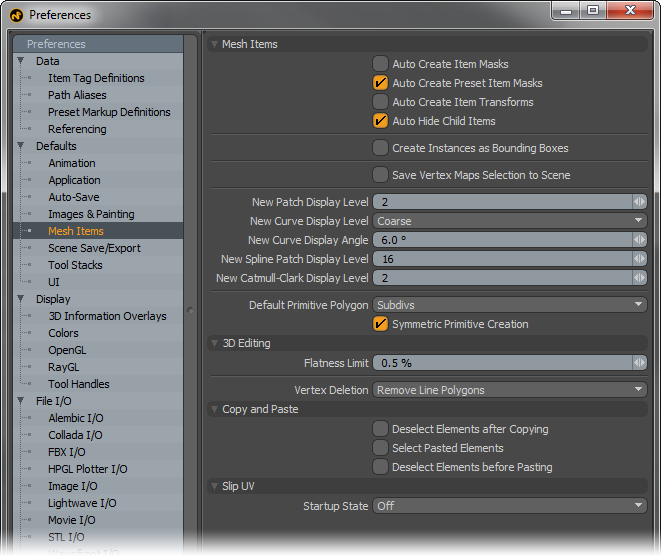
Mesh Items--
Auto Create Item Masks: When this option is enabled, an 'Item Mask' is automatically generated for each new item layer that is created in the Items list.
Auto Create Preset Item Masks: When this option is enabled, an 'Item Mask' is automatically generated for each new mesh preset item that is added to any scene. This can be especially helpful to limit shader tree layers to the specific preset should there be material tag naming collisions (i.e. identical named material tags between existing layers and the preset).
Auto Create Item Transforms: When new items are created in the item list, by default, they do not have specific transform channels in the channels viewport ('Position', 'Scale' and 'Rotate'). Enabling this option instructs MODO to create the 3 basic transform channels for all new items.
Auto Hide Child Items: Users can create hierarchies of elements in a scene, and relate elements under 'Group Locators' for organization. The 'Auto Hide Child' option, when enabled will allow users to toggle visibility of all related child layers when any parent layer is toggled. When disabled, layer visibility in a hierarchy is toggled individually per layer.
Create Instances as Bounding Boxes: By default, MODO displays instanced items as full wireframe representations of the source item. When this option is enabled, MODO will instead display only bounding box representations of instanced items. This can improve display performance for heavily instanced scenes.
Save Vertex Maps Selection to Scene: When this option is enabled, any selected vertex maps will remain selected when the file is closed and later re-opened. When disabled, all vertex map selections will reset with no maps being selected when the file is re-opened.
New Patch Display Level: Determines the default Patch level for Subdivision Surfaces items. Higher values produce smoother results but generate more geometry. Users can manually adjust the Patch display level for each Item in the Items Properties.
New Curve Display Level: Determines the default amount for how smoothly Curves are displayed in the 3D viewports. Users can choose between 'Course', 'Medium' and 'Fine'.
New Curve Display Angle: The 'New Curve Display Angle' defines the default value that controls how curves are quantized for display and freezing. This is analogous to the patch resolution for subdivision surfaces.
New Spline Patch Display Level: This option determines the default 'Spline Patch Level' for Patched surfaces. Users can manually adjust this value in the Item properties.
New Catmull-Clark Display Level: Determines the default Catmull-Clark Subdivision Surfaces subdivision level. Higher values produce smoother results but generate more geometry. Users can manually adjust the subdivision level for Catmull-Clark surfaces in the Items Properties viewport.
Default Primitive Polygon: Certain Primitive mesh objects (such as the 'Sphere' and 'Torus') have an option that sets the type of polygons the tool generates. The 'Default Primitive Polygons' option defines the default state for these values.
Symmetric Primitive Creation: When this option is enabled in conjunction with the symmetry option, any primitives that are created, such as a cube or a sphere, an identical mirrored version is also created across the line of symmetry.
3D Editing--
Flatness Limit: This value determines the threshold at which a polygon is considered to be planar or non-planar. Higher values will designate less and less polygons as being non-planar. Users can use the Statistics panel to select these types of polygons automatically.
Vertex Deletion: This setting determines what action MODO takes when all but two vertices of any given polygon are deleted-
Remove Line Polygons- This option will remove the remaining 2-point polygons that result from the action, but retains the vertices from surrounding polygons if shared. This option is the default value and is recommended for most users.
Keep All Polygons- This options retains the 2-point polygons (also known as line polygons). The remaining 2-point polygon does not render, but can be used like a polygon or an edge, and can be extruded and extended into a full polygon.
Copy and Paste--
Deselect Elements after Copying/Select Pasted Elements/Deselect Elements before Pasting: The default clipboard behavior in MODO is when Pasting 'Copied' elements, the original selection remained active and the newly pasted geometry is inserted unselected dictating a specific workflow or workarounds in certain situations, such as copying part of some geometry on top of itself into the same layer, there was no way to accurately select the newly inserted geometry without creating a new layer and shuffling the elements between them. With these options, users can now have MODO automatically select/deselect elements, also providing a workflow familiar to many graphics applications.
Startup State: Sometime the Slip UVs option will accidentally breaks a UV maps when the user forgets to turn it off. The Slip UV 'Startup State' option will help users to automatically disable it each time the tool itself is dropped. "Off" means 'Slip UV' is always off when a tool is activated; and is the default setting. "Last Selected" is the original behavior for the tool, where the 'Slip UVs' state is retained.
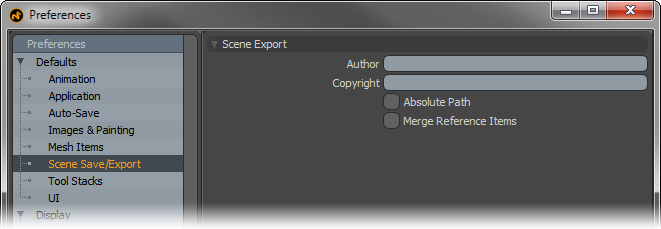
Scene Export--
Author/Copyright: These values, when defined, are embedded within saved and exported files (where supported).
Absolute Path: When this option is enabled, MODO will write all link references (such as those to images, MDDs and IES files) as Absolute Paths referencing their location to specific areas of a disc drive when saving files. When disabled, MODO uses relative paths to locate linked files.
Merge Reference Items: When utilizing Scene Reference items, users can enable this option to embed the referenced items into the scene file when saving, instead of having them remain external entities.
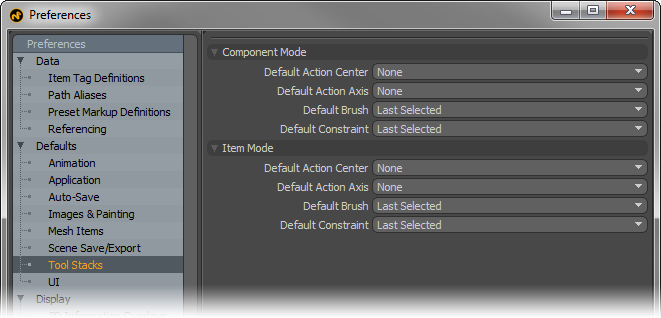
Tool Stacks--
The 'Tool Stacks' options allow users to define default states for different function for both the component selection modes (Vertices, Edges and Polygons) and for Items selection mode.
Default Action Center: Users can use this option to determine the default Action Center when MODO is first opened.
Default Action Axis: Users can use this option to determine the default Action Axis when MODO is first opened.
Default Brush: Users can use this option to determine the default Brush Tip that will auto select when utilizing any sculpting or painting brush. 'Last Selected' will obviously return the Brush to its prior state.
Default Constraint: Users can use this option to determine the default Constraint type when MODO is first opened.
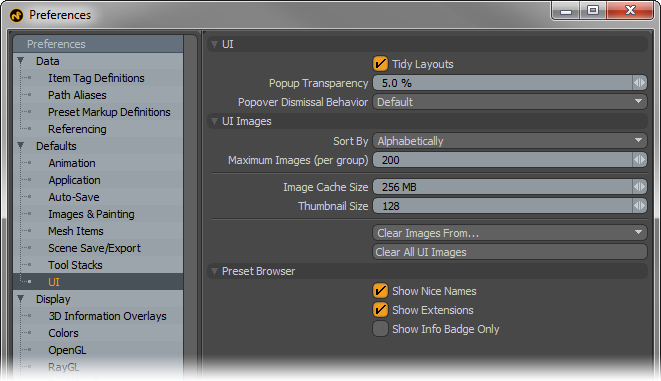
UI--
Tidy Layouts: MODO's interface is made up from a collection of viewports. Viewports always have a frame users can use to resize the window. When multiple viewports are nested within each other, multiple viewport frame borders become unnecessary, the 'Tidy Layouts' option, enabled by default, removes these subsequent viewport frames providing a few pixels of additional screen real-estate as well as a cleaner UI. However, user may wish to disable the setting to better see how viewports relate to one another for the purposes of interface customization.
Popup Transparency: The 'Popup Transparency' percent value controls the transparency of Popup windows, Popovers and Pie Menus. Higher values make the Popups more transparent, allowing the background to been seen through them (making them less obtrusive) but also more difficult to read the contents. This may affect performance on some systems.
Popover Dismissal Behavior: This options can be used to override the dismissing behavior for Popovers. The 'Default' option retains the hard coded behavior. 'Force Click-Off' makes sure that Popovers remain open until explicitly clicked away from and 'Force Roll-Off' will dismiss the window when the cursor is simply rolled away from it. This only affect simple popovers, point at popovers are always click-off.
UI Images--
Sort By: This option determines how images are sorted in UI viewports such as the Clip Browser function. Images are sorted 'Alphabetically' or they are sorted by 'Age' with the most recently imported images appearing at the top of the list.
Maximum Images (per group): Determines the maximum number of clips (stills or animations) that can be loaded into a Clip Browser.
Image Cache Size: Determines the maximum amount of RAM dedicated to holding all user interface thumbnails, such as those generated for imported images, image inks and brush tip images.
Thumbnail Size: Determines the pixel resolution for auto-generated user interface thumbnails.
Clear Images From...: Users can open this menu to choose from multiple user determined options to remove images from in the user interface. Once a particular command is invoked, images in that functions 'Clips Browser' will be removed from display, clearing memory.
Clear All UI Images: This option will clear all latent images from the various Clip Browsers for the tools, i.e. the Image Ink browser, Brush Tip Browser, etc.
Preset Browser--
Show Nice Names: Shows underscores as spaces for file names in the Preset Browser.
Show Extensions: Shows the file extension for file sin the Preset Browser.
Show Info Badge Only: When enabled, this option only shows the 'i' badge icon over thumbnails in the Preset Browser. This setting will only affect thumbnail views, as badges are always shown in 'List' mode.


